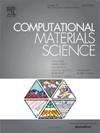Effect of strain and external electric field on the optoelectronic properties of HfS2/ZrSe2 heterostructures
IF 3.1
3区 材料科学
Q2 MATERIALS SCIENCE, MULTIDISCIPLINARY
引用次数: 0
Abstract
The strain’s electrical structure and optical characteristics as well as the electric field acting HfS2/ZrSe2 heterojunction structure have been calculated by a first-principles approach based on density functional theory. A strain of −6%-6% is applied to the HfS2/ZrSe2 heterojunction to analyze the changes in energy bands, density of states, dielectric function, and absorption coefficient. An electric field was also applied to the HfS2/ZrSe2 heterojunction structure in the range of ± 0.08 V/Å with the increment set to 0.02 V/Å to analyze the electronic structure and optical properties. It is found that the heterojunction structure has an increasing gap when subjected to tension and a decreasing band gap under compressive strain. When the compressive strain exceeds −4%, the heterojunction structure is transformed from semiconductor to metal, and the electrical conductivity is greatly improved; the highest absorption coefficient and the most obvious changes are observed when compressed to −6%; the direct band gap is always maintained under the action of the electric field which is beneficial to the material’s use of light. A decrease in the band gap under the action of a positive electric field makes it easier for electrons to jump and promotes charge transfer.

求助全文
约1分钟内获得全文
求助全文
来源期刊

Computational Materials Science
工程技术-材料科学:综合
CiteScore
6.50
自引率
6.10%
发文量
665
审稿时长
26 days
期刊介绍:
The goal of Computational Materials Science is to report on results that provide new or unique insights into, or significantly expand our understanding of, the properties of materials or phenomena associated with their design, synthesis, processing, characterization, and utilization. To be relevant to the journal, the results should be applied or applicable to specific material systems that are discussed within the submission.
 求助内容:
求助内容: 应助结果提醒方式:
应助结果提醒方式:


